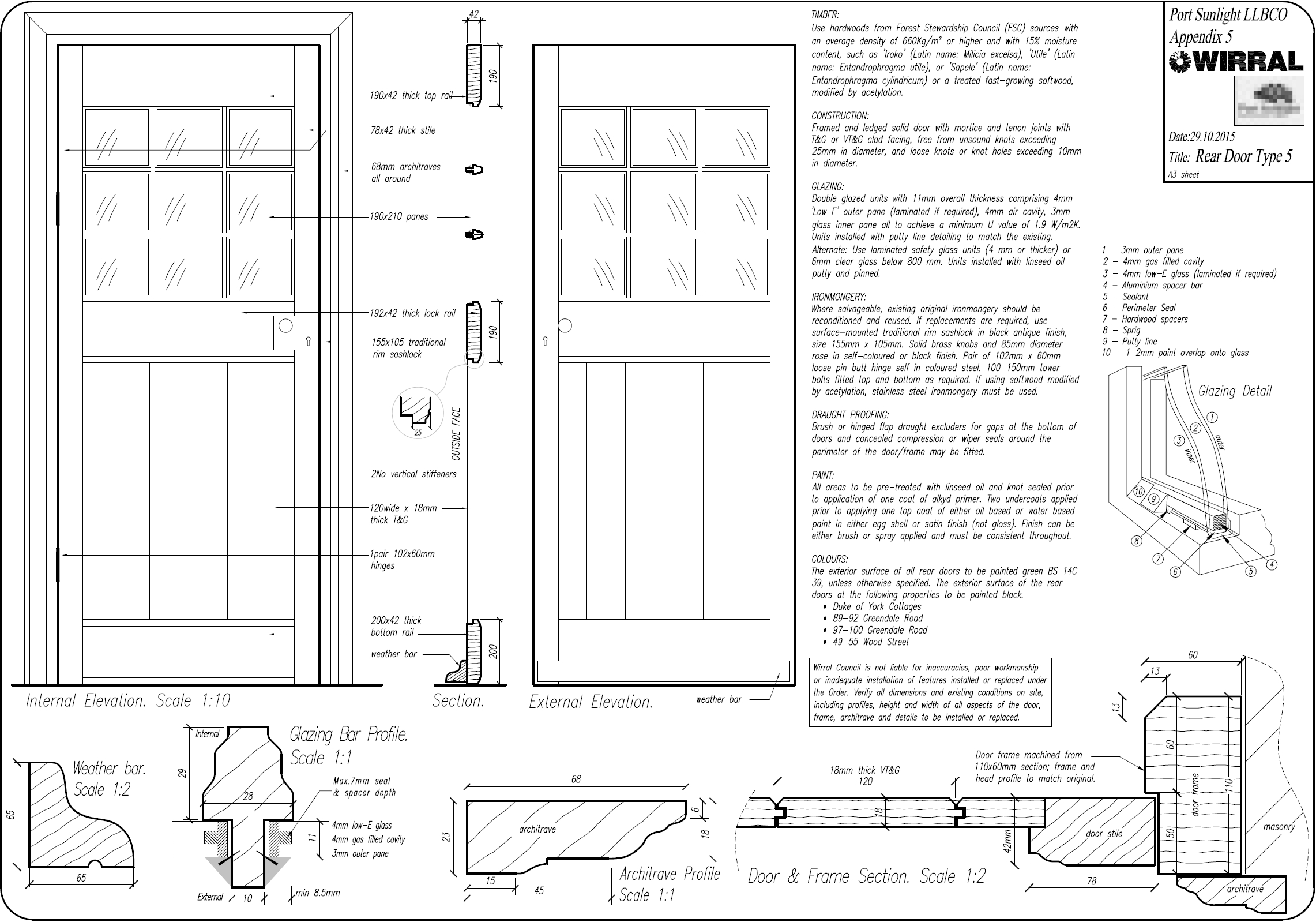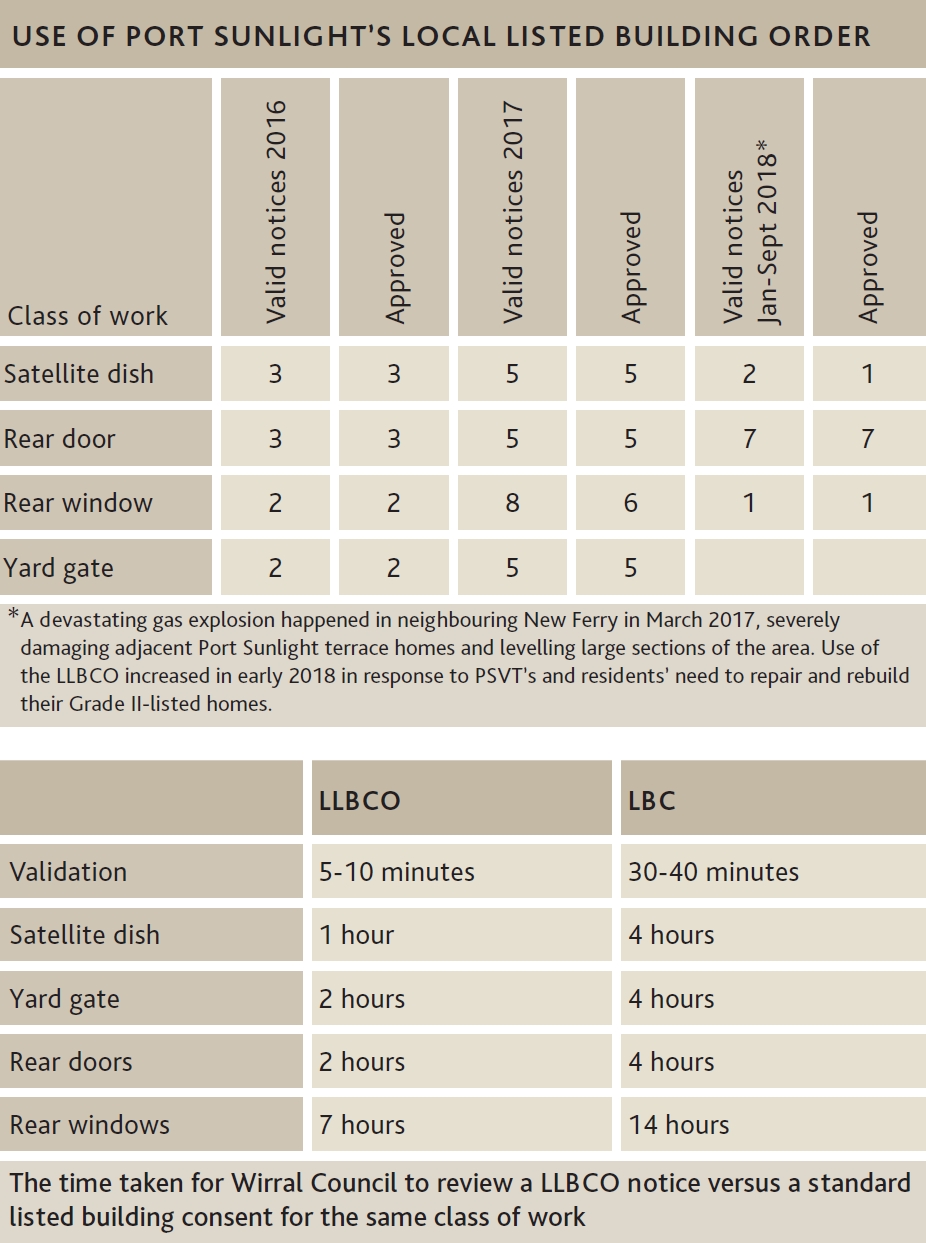Port Sunlight's local listed building order
Contents |
Introduction
Port Sunlight Village Trust and Wirral Council worked with the support of Historic England and the community to develop a local listed building consent order to manage change in the village.

|
| Appendix 5 of the LLBCO: one of the five door design specifications for replacement rear doors (Image: Port Sunlight Village Trust and Wirral Council). |
The Enterprise and Regulatory Reform Act of 2013 introduced local listed building consent orders (LLBCOs) to ‘establish well-understood approaches to common issues of maintenance, repair or minor alteration, to increase certainty over the aspirations and requirements of all parties, and to save time and resource for owners and local planning authority alike’ (Historic England Advice Note 6, Drawing Up a Local Listed Building Consent Order).
Adopted in November 2015, the Port Sunlight LLBCO was one of the first in the country. Its contribution as a proactive heritage policy initiative was recognised with a Historic England Angel Award in 2016.
Port Sunlight, the vision of industrialist William Lever, was built as a model village to house workers at his soap factory, Lever Brothers, which went on to become the global manufacturing giant Unilever. Lever provided his workers with sanitary housing, access to open green space, allotments, schools, a hospital, a church, a swimming pool, art and literature, and access to wholesome leisure activities and training opportunities.
The village gave Lever the chance to express his interest in architecture and town and country planning. From 1888–1938 over 30 architectural practices were involved in the design of the village. A wide variety of revival style English domestic designs were used, giving the impression that the village had developed over four centuries, rather than within 50 years. Contrasting styles were placed alongside each other to create interest, and no two terraces are identical.
Port Sunlight Village Trust (PSVT) is an independent charity established in 1999. Its vision is ‘to make Port Sunlight an inspiring place to live, work and visit’. As guardians of Port Sunlight’s unique heritage, PSVT ‘works with the community and partners to ensure a great quality of life for residents and to celebrate William Lever’s legacy through cultural and learning experiences for all’.
Registered landscapes
The trust maintains 130 acres of parks and gardens, eight listed monuments and memorials, 16 community and commercial buildings and 292 of the 900 Grade II-listed residential properties in the village. The other 600 houses are privately owned, sold by Unilever prior to the establishment of PSVT. The entire village is a designated conservation area, and two landscapes, The Dell and The Diamond, are included in the Register of Historic Parks and Gardens of Special Historic Interest in England.
Several factors contributed to the decision to develop a LLBCO for Port Sunlight. These include:
- a desire to support residents in their efforts to restore their properties
- repetitive listed building consent (LBC) applications
- common heritage enforcement issues at the backs of the houses
- Wirral Council restructuring and budget cuts
- high density of listed sites with moderate market value
- a developing partnership between PSVT and Wirral Council.
The aims of the Port Sunlight LLBCO are to reduce costs for residents by drawing and specifying appropriate replacement features; streamline and clarify consent for the most common LBCs; provide clear and reliable information to empower property owners to address enforcement issues; and reduce capacity strain on Wirral Council.
Based on the results of an exterior conditions survey of the houses in the village, demand demonstrated by the LBC history and the lack of understanding about appropriate replacement yard gates, the Port Sunlight LLBCO includes replacement of severely deteriorated or inappropriate yard gates; rear windows and rear doors; and appropriate installation of satellite dishes.
The LLBCO includes construction drawings and specifications for replacement rear doors. Residents can choose from five approved designs. There is just one option for a replacement yard gate and, like the doors, this is drawn and specified.
Rear windows proved more challenging. Despite some consistency across rear window types and details at the backs of the houses, it was not possible to draw and specify a replacement window for each house. Instead, window type (such as Yorkshire sliding sash) and construction are specified. The owner must provide detailed and dimensioned drawings of the proposed replacement windows (based on the construction specified, the window type listed for their property in the window schedule for the LLBCO, and extant physical evidence) before notice is accepted.
Alterations
Although all listed houses in the village can use the replacement rear doors and yard gate specified in the LLBCO, the project partners were not able to identify original rear window types or configurations for all houses due to extensive alterations at the back of some terrace houses and insufficient archival evidence. Replacement rear windows for the houses excluded from the LLBCO require full listed building consent.
In the first full year of the LLBCO (2016), residents submitted 10 valid notices for works. Wirral Council approved all valid notices. As the table illustrates, use of the LLBCO has increased steadily since adoption.
The elements of work covered by the LLBCO have already been approved, so the time spent assessing each proposal is limited to ensuring that the notice complies with the drawings and conditions of the LLBCO.
PSVT’s partnership with Wirral Council, established by the LLBCO, enabled a coordinated response to the March 2017 gas explosion. The partners worked together to develop master plan LBCs to rebuild the damaged terraces. This involved archival research at Wirral Archives and Unilever Art, Archives and Records Services, which uncovered photographic evidence of early terrace houses in the village that had previously been unavailable. These photographs illustrate original rear windows for several of the terrace houses that had been excluded from the LLBCO due to insufficient archival and physical evidence.
PSVT produced an information booklet (developed in partnership with Wirral Council and supported with funding from Historic England’s Heritage Protection Commissions grant programme) to promote the LLBCO, and to inform both residents and tradespeople on the threshold standards for use, notice processes and documentation requirements. This information is also found on Wirral Council’s website and the Port Sunlight residents’ website (http://www.portsunlightresidents.com) as part of an interactive house developed to aid residents with the best-practice care and management of their listed homes. PSVT staff and Wirral Council’s conservation officer hosted resident engagement sessions to explain the LLBCO process and why it had been introduced into the village.
Positive feedback
To understand the effectiveness of the LLBCO it has been essential to gain feedback from residents: whether they believe the application process is user friendly, the guidance is clear and design specifications are easy to follow. A number of interviews were held with residents who used the LLBCO. The feedback has been overwhelmingly positive. With this feedback in mind and a similar response from Wirral Council regarding time savings for processing LLBCO notices versus full LBCs, PSVT is optimistic about the second phase of the LLBCO.
The first step will be to amend the existing LLBCO to include rear window replacement for terraces that had previously been excluded due to insufficient archival evidence. Regarding additional classes of work, PSVT and Wirral Council are keen to include appropriate installation of boiler flues and external pipework.
The Port Sunlight LLBCO has been a successful partnership project between a local council and a conservation area. Resident feedback and council statistics demonstrate the value of the initiative and indicate that LLBCOs could be implemented in other areas to support both heritage and the communities who own and care for it.
For more information, visit http://www.portsunlightvillage.com
This article was originally published in IHBC's Context 158 (Page 53) in March 2019. It was written by Heather Alcock, heritage conservation officer for Port Sunlight Village Trust, and one of the authors of the local listed building consent order. Lizzie Heywood is the trust’s asset management officer (conservation).
--Institute of Historic Building Conservation
Related articles on Designing Buildings Wiki
IHBC NewsBlog
Old Sarum fire in listed (& disputed) WW1 Hangar - Wiltshire Council has sought legal advice after fire engulfed a listed First World War hangar that was embroiled in a lengthy planning dispute.
UK Antarctic Heritage Trust launches ‘Virtual Visit’ website area
The Trust calls on people to 'Immerse yourself in our heritage – Making Antarctica Accessible'
Southend Council pledge to force Kursaal owners to maintain building
The Council has pledged to use ‘every tool in the toolbox’ if urgent repairs are not carried out.
HE’s Research Magazine publishes a major study of the heritage of England’s suburbs
The article traces the long evolution of an internal programme to research 200 years of suburban growth
IHBC Context 183 Wellbeing and Heritage published
The issue explores issues at the intersection of heritage and wellbeing.
SAVE celebrates 50 years of campaigning 1975-2025
SAVE Britain’s Heritage has announced events across the country to celebrate bringing new life to remarkable buildings.
IHBC Annual School 2025 - Shrewsbury 12-14 June
Themed Heritage in Context – Value: Plan: Change, join in-person or online.
200th Anniversary Celebration of the Modern Railway Planned
The Stockton & Darlington Railway opened on September 27, 1825.
Competence Framework Launched for Sustainability in the Built Environment
The Construction Industry Council (CIC) and the Edge have jointly published the framework.
Historic England Launches Wellbeing Strategy for Heritage
Whether through visiting, volunteering, learning or creative practice, engaging with heritage can strengthen confidence, resilience, hope and social connections.















